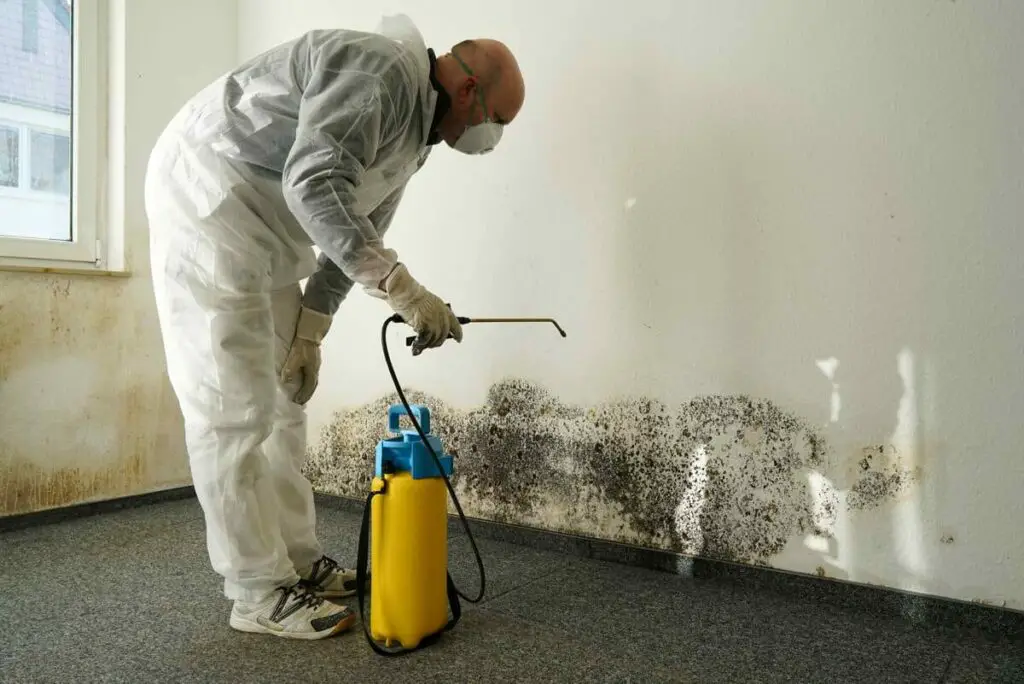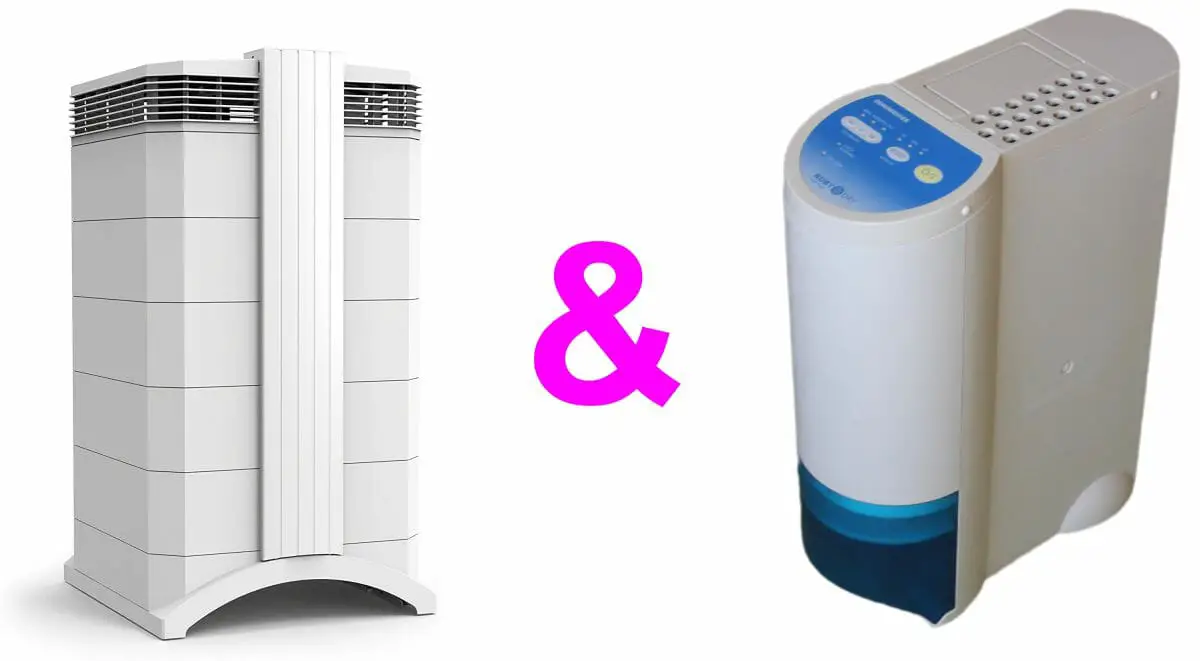It is a really great idea to consider purifying your air and also at some times of the year using a dehumidifier. So should you combine an air purifier and dehumidifier?
What if combining the two was to lead to a tradeoff of particle reduction versus the removal of water vapor? Which is the most critical aspect in the removal of airborne particles and chemicals by the air purifier or the removal of water vapor by the dehumidifier?
The WHO has moved the safe limit for fine airborne particle exposure down to 5 mcg/m3, and current US government statistics show that 98% of Americans live in areas with higher concentrations of airborne particles than this.
It is also now well established that airborne particles can cause heart attacks, dementia and death. There are also many other health effects-
Airborne particles have been shown in clinical or epidemiological studies, often multiple studies, to cause-
- Coronary heart disease-heart attacks
- Strokes
- Premature aging of the lungs
- Chronic obstructive pulmonary disease
- Pneumonia
- Cancer
- Lymphoma
- Diabetes
- Skin problems including skin aging
- Autoimmunity
- Osteoporosis
- Diabetes
- Kidney disease
- Dermentia
- Cognitive decline-decrease in thinking ability
- Parkinson’s disease
- Vision impairment-age related macular degeneration and glaucoma
- Impairment of sense of smell
- Sleep disturbance
- Depression
- Anxiety
- Increased risk of psychiatric problems
- Decrease in fertility
- Increased miscarriage
- Exposure during pregnancy linked to neurological problems, asthma, lower IQ in child
- Children-lower intelligence and delayed psychomotor development, faster decline in cognitive function in adulthood
- Children-chest infection, asthma
- Children-increased obesity
- Children-increased psychiatric problems
- Children-death rate increased
- Premature aging?-ultrafine particles speed up several processes involve in aging
- Premature death
So we really do not want to compromise on air purifier function for the sake of having a single unit.
As a general rule, you should not buy a combined air purifier and dehumidifier, as a good air purifier needs a very high air flow and a good dehumidifier a low air flow. The compromise needed to combine them gives you the worst of both worlds.
It’s like insisting that an athlete becomes a champion weight lifter and ballerina at the same time! It will lead to doing neither well. Just as you would be much better off having an Olympic weight lifter and a lifelong ballerina, it is much better to have a separate specialized air purifier and dehumidifier.
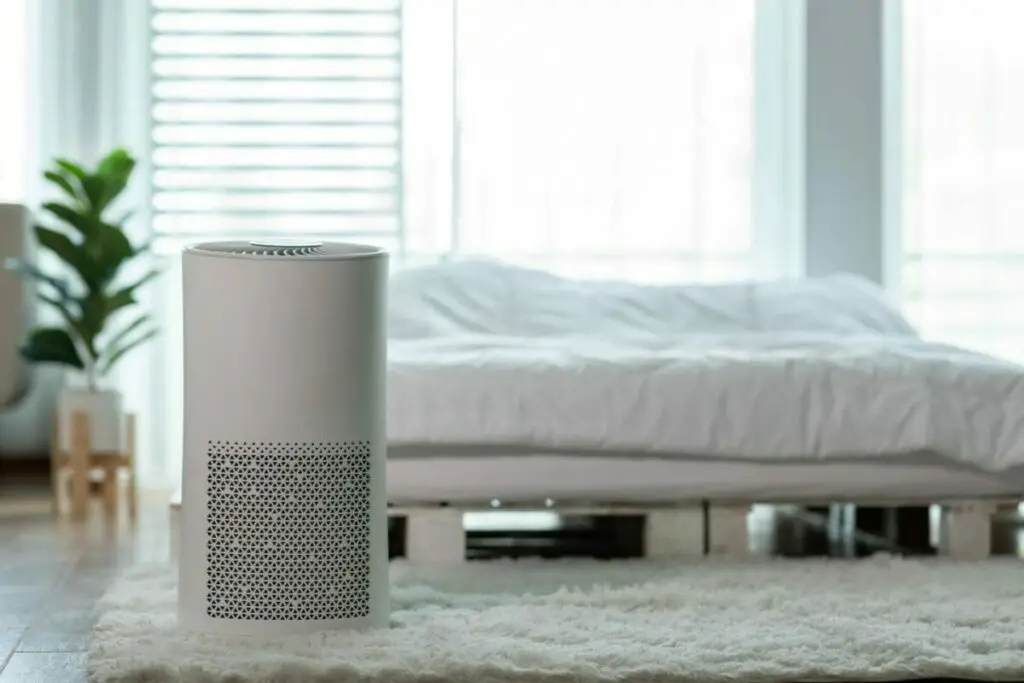
The air purifier needs a very high air flow to process the indoor air through the HEPA filter, processing a volume of air equal to the volume of the room at least 5 times per hour to achieve the EPA’s recommended reduction in airborne particles by a minimum of 80%. However, the dehumidifier needs the air flow to be slow so that the air is in contact with the cooling coils for long enough for it to cool to such an extent that the water vapor condenses out and drips into the collecting tank, so lowering the humidity level in the air.
There is sometimes a need for both the dehumidifier and an air purifier to improve your indoor air quality. Buying the units separately allows you to pick the most effective models for each function. Unfortunately, this does mean that you have 2 appliances in the room rather than one. Let’s look at the functions of dehumidifiers and air purifiers and then see what is on the market, and the compromises that are needed to buy them as a single unit.
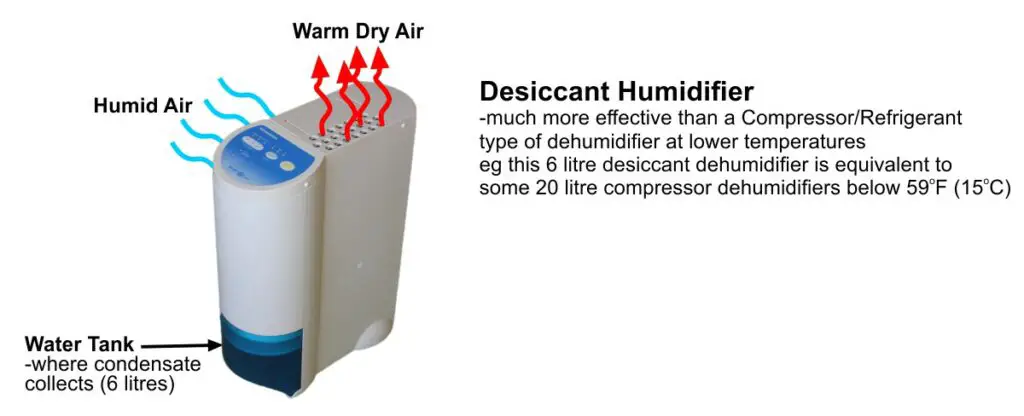
Dehumidifier vs Air Purifier
An air purifier is a machine that removes airborne particles and chemicals. A dehumidifier removes water molecules from the air. So they both remove things from the air but there is no overlap. An air purifier does not remove water molecules, these molecules are so small that they can simply pass through the HEPA filter, and the dehumidifier does not remove particles or chemicals from the air.
A dehumidifier reduces the moisture level in the air and keeps the relative humidity down. Keeping the relative humidity below 55% stops house dust mite multiplying, and below 80% stops mold growing so that there are fewer mold spores in the air. Whilst both these allergens are unpleasant and can affect people with allergies, asthma or some lung conditions, there is not the long list of very serious complications that result from fine (PM2.5) and ultrafine particles in the air which an air purifier removes.
Also, if some water molecules are not removed, this will not directly harm human health. Conversely, not removing fine airborne particles and chemicals from the air may directly harm your health. In addition, it is relatively easier to remove water vapor from the air effectively than it is to remove fine and ultrafine airborne particles and chemicals from the air.
Removing excess humidity, dehumidification, is easy for a home owner. The technology to remove water vapor from the air is basic and long established-
- Thermo-electric (Peltier)-lower capacity for removing water
- Compressor/Refrigerant Cooling Coils-the usual technology in a dehumidifier. It works in a similar way to a fridge
- Desiccant Dehumidifier-the desiccant absorbs water from the atmosphere and then is dried within the machine by warming the discs and collecting the water. These can operate at much lower temperatures than Thermo-electric or compressor/refrigerant dehumidifiers.
So you can simply switch the dehumidifier on, and set the humidity target that you are aiming for!
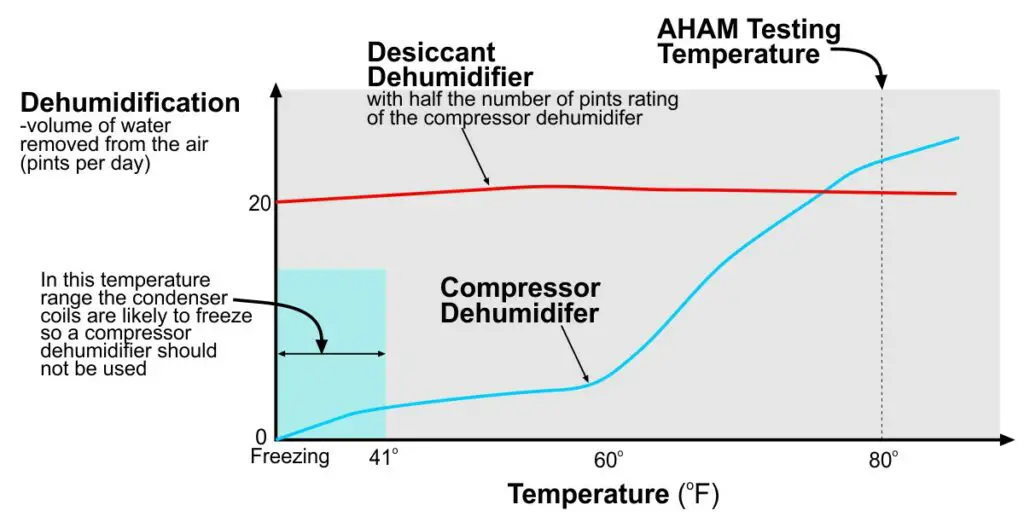
Air Purification
In contrast air purification is much more difficult to do effectively than many people realize. You need a HEPA air purifier that has a clean air delivery rate (CADR), “airflow”, that is high enough for your room, while the air purifier is operating at a noise level that you can tolerate for long periods.
1) HEPA Filtration
HEPA filtration is really the gold standard for air purification. These filters will remove 99.97% of all particles of 0.3 micrometres in diameter, they will remove even more larger and smaller particles until the particle size becomes very small indeed certainly less than 0.1 micrometres. Examples of the particles these filters will easily remove –
- House dust mite
- Pet dander
- Pollen
- Mold Spores
- Dust-household and atmospheric
- Bacteria
- Viruses
- Brake dust
- Tire dust
- Vehicle exhaust particles
- Smoke particles both cigarette and wildfire
When buying an air purifier, please be very careful to buy one with a true HEPA filter, do not buy one with a “HEPA like”, “99% HEPA”, “HEPA style”… as these filters will not be up to HEPA specification.
2)Activated Carbon Chemical Filtration
Although a HEPA filter is by far the most important filter, it is also good to have an activated carbon filter to remove chemicals which can be significant airborne contaminants. In removing volatile organic compounds, these filters can get rid of odors such as a musty smell.
Further information about both filter types can be found here, “How Air Purifiers Work“.
3)Having an Adequate Air Flow (clean air delivery rate-CADR)
Although buying an air purifier with an adequate air flow sounds easy, the difficulty is that most manufacturers usually only give you the CADR at the maximum airflow for the air purifier.
Almost invariably, this maximum setting produces such a loud noise that no one would sit in a room with it on this setting for long. If you then switch the air purifier speed down to lessen the noise, having sized the air purifier for your room using the maximum CADR, you will now have inadequate air quality and potential adverse health effects.
So you usually need the noise level and CADR on 1 or 2 settings down from the maximum. Less than 5% of manufacturers have this in their manuals/websites so that you will have to approach customer service and maybe 20% of the time customer service does not have this information. (Alternatively, you could just buy the recommendations from this website as I do not recommend any air purifiers for which the manufacturer will not give this information. So it is taken into account in all the reviews on this site).
When you get your air purifier home, you need to be sure that it is being effective in your room. The only way to do this is to have an air quality meter and take a reading before the air purifier is switched on and a reading after it has been on for one hour. The EPA specified that there should be an 80% reduction in particle count. If you are measuring AQI then be less than 5 mcg/m³ or less, and ideally it should be 1 mcg/m³ or less.
Air Purifier and Dehumidifier Combined Current Top Recommendations on the Web and Their Problems
A combined air purifier and dehumidifier is sometimes called an “air purifier combo” or “dehumidifier combo”. On the web these are the top 4 recommendations-
Tenergy Sorbi 1000ml Air Dehumidifier w/Air Purifying Function
The main problem with this choice is that the clean air delivery rate is 22 cfm. It only be suitable for purifying the air in the room of 34 square feet. So that would be a room 5.8′ x 5.8′. I am not sure if many people have rooms so small. So this top rated choice is not much use as an air purifier.
hOmelabs 70 Pint Dehumidifier
This model has been discontinued, but looking at the hOmelabs 50 pint dehumidifier the manufacturer makes no claims about air purification. In the listing for the home labs 70 pints it mentions a washable filter. As no true HEPA filters are washable because doing so damage them, this cannot be true HEPA filter. Usually, washable filters are very tough but very poor at stopping particles. So this machine does not seem to have an adequate filter to purify the air and protect your health.
Aprilaire 1800 Series
The problem with the April air 1800 series is that it only has a MERV 8 filter. These filters are not designed for air purification they are simply there to protect the machinery of the device. They will let through approximately 70% of particles in the range of 0.1 – 0.3 micrometres. When you consider that a HEPA filter, the basic standard for air purifiers, will only let through 0.03% of particles this size you can see that a MERV 8 filter is not good enough to protect human health.

Afloia Q10
Peltier dehumidification which is less efficient. The air purification is certified by California Air Resources Board, however the company does not specify the CADR in the manuals or on the website. It is said to be capable of servicing a room of 161 sq ft and reportedly the minimum noise level even at the slowest speed is 50.6db. At the slowest speed, it is not certain what room size it would serve, but it will be less than 161 sq ft. Also, I usually advise people to consider carefully before buying an appliance that is noisier than 50db so this machine may well be too noisy for most people.
Why Do So Few Corporations Produce a Combined Air Purifier and Dehumidifier?
An effective dehumidifier needs to have a large water tank, so that you are not having to empty it more than once a day. The condenser also needs to be a reasonably large size to remove water from the air. Also, air purifiers with high air flows need to be relatively large.
So putting these 2 fairly large units together would lead to a very bulky and heavy machine, to the point where it is better to have 2 separate machines. These small machines can then be more easily integrated into the room, and more specialized to the particular needs of the room. For instance, the room may need excellent particle or chemical filtration but only a small amount dehumidification or vice versa.
Also manufactures are likely to be better at making air purifiers or dehumidifiers but are unlikely to produce both the best air purification and dehumidification. So you’re best buying the air purifier from the manufacturer that is best at making air purifiers and the dehumidifier from the manufacturer that is best at making dehumidifiers.
Using an Air Purifier With Dehumidifier
On the whole, using an air purifier with the dehumidifier at the same time in the same room is not a problem. In fact the effectiveness of air purifiers decreases when the relative humidity reaches 90% or above. So if your indoor air is more humid than 90% an air purifier will actually work better with a dehumidifier, provided the dehumidifier can reduce the humidity below 90%.
What are dehumidifier air purifier combos?
A dehumidifier air purifier combo is a machine combining air purification with dehumidification. This often ends up with either the dehumidification or air purification or both being compromised.
How do dehumidifier air purifier combos work?
A dehumidifier air purifier combo is a machine in which air is sucked through a filter by a fan and then passed over condensing coils or desiccant media to remove the water vapor. The problem is to be a good dehumidifier it needs a slow airflow but for it to be a good air purifier it needs a very high airflow. The low airflow usually predominates and means these machines can only purify the air of very small rooms.
Should you get a dehumidifier or an air purifier?
As a general rule, an air purifier will benefit virtually anyone, whereas a dehumidifier will only benefit those whose home’s relative humidity is above 55%. Also the potential health benefits from an air purifier are usually much greater, as airborne particles are associated with heart attacks, dementia and premature death. For further information please see this article “Airborne Particles Affect Us All Now“.
Air purifier or a dehumidifier for allergies?
There are benefits for allergies from both an air purifier and a dehumidifier. An air purifier will remove airborne particles from the air which irritate the airways. If the relative humidity in the home is above 55% then a dehumidifier will stop house dust mite multiplying. It will also stop mold growing at a relative humidity of greater than 80%.
Can you use a dehumidifier and air purifier to remove mold?
As a general rule, you cannot use a dehumidifier and air purifier to remove mold. A dehumidifier can stop mold growing if the relative humidity is above 80%, by reducing it below 80%. An air purifier can remove house dust mite and mold spores particles from the air but cannot stop the mold from continuing to grow. First any leaks that caused an area of the home to be damp will need to be repaired so that moisture is not continuing to provide an ideal growing environment for the mold. Then the mold will need removing physically and the area where it was treating with chemicals to prevent further growth.
Which device should you choose if you have asthma?
If you have asthma and the particle count is high in your area then an air purifier will benefit you all year round no matter what the relative humidity. The dehumidifier will only be helpful if your home’s relative humidity is above 55%. This is because when the relative humidity is above 55% house dust mite can survive and start to grow. When the relative humidity is higher than 80% mold can grow in your home. Both house dust mite and mold can aggravate asthma.
There is a helpful article on the best air purifier for asthma-“Best 4 Medical Grade Air Purifiers for Asthma“.
Air Purifier Essential Information
In one review of studies where air purifiers were used, fine particulate matter was reduced between 23-92%. Bear in mind the EPA recommends a minimum reduction of 80%. So even in experimental studies with training in how to use the air purifiers, most air purifier users failed to hit this target. On the other hand, it shows that air purifiers, when used well, can decrease particle count by 90%. This just emphasizes the importance of how you use the air purifier.
- Buying an air purifier-the air purifier should have a true HEPA filter, adequate air flow (CADR) at a noise that you can tolerate for long periods. The air purifier should be “smart” that is programmable or capable of being made smart. The most difficult part is buying one with an adequate air flow at a noise that you can tolerate for long periods as most air purifiers are too loud on their maximum fan speed and manufacturers usually do not give data on air flow and noise at lower fan speeds. There is helpful advice about buying an air purifier here-“Buying an air purifier”. Alternatively, just buy the recommendations on this site. If you want the quietest air purifier you may wish to read this article-“Best Quiet Air Purifiers“, if you need one that will remove particles very well but is particularly good at removing chemicals from the air, for example from forest fires, please see this article-“Best Air Purifier for Smoke“.
- Position the air purifier at least 12 inches from any wall-so that the air coming out of the air purifier joins in with the circulation of air in the room. There is advice about using an air purifier in this article-“How to Use an Air Purifier“.
- Run the air purifier for at least 30 minutes before entering the room. This is because it takes an air purifier this long to reduce the particle count in the room. So the air purifier that you buy needs to be smart or capable of being made smart by plugging it into a smart plug.
- Run the air purifier continuously when you are in the room at the highest setting that you can tolerate long term. This is because the higher the setting that you run the air purifier on the lower the particle count in the air will be. There is no lower threshold known below which human health does not improve, so the lower the particle count/PM2.5 the better. Health aspects of particle count/PM2.5 are outlined in this article-“Airborne Particles and Chemicals Affect Us All Now“.
- Never run the air purifier using its inbuilt sensor-there are 7 reasons that you should not do this as outlined in this article-“How to Use an Air Purifier“.
- Always test the air with an air quality meter where you are going to sit at the height in the room where your mouth and nose are. Comparing the measurements before and 45 minutes after switching the air purifier on there should be at least an 80% reduction in particle count as the EPA recommends. Testing that the particle count/PM2.5 is adequately reduced by your air purifier is the most important thing that you need to do. Air quality meters can be brought really quite cheaply eg $35, there is a helpful article about them here-“How to Test Air Quality in Your Home“.
- How many air purifiers do I need?-at least 2 but maybe 5 or more. Please see this article “How many air purifiers“.
Summary
Having a combined air purifier and dehumidifier will lead to a compromise on the air purification function. Air purification is really more difficult than it looks to do properly. It is very important to do it as well as possible to protect your and your family’s health. So you need the highest quality air purifier that you can buy. There are much better standalone air purifiers than you can get in a combination machine with the dehumidifier. Therefore, I would recommend against buying a machine that combines a dehumidifier with an air purifier.
Features of an air purifier versus a dehumidifier are easy to explain, an air purifier removes airborne particles and chemicals but does not remove water molecules, as molecules are so small that they can go straight through the very small holes in the HEPA filter. A dehumidifier removes water molecules from the air but does not remove airborne particles and chemicals. So they are perfectly complimentary machines. There is a helpful article about this here-“Air Purifier vs Dehumidifier“
Consequently, having an air purifier and the dehumidifier on in the same room is not a problem. In fact if the relative humidity is above 90% then lowering the humidity with a dehumidifier will help the air purifier work efficiently.
Related Questions
Related Articles
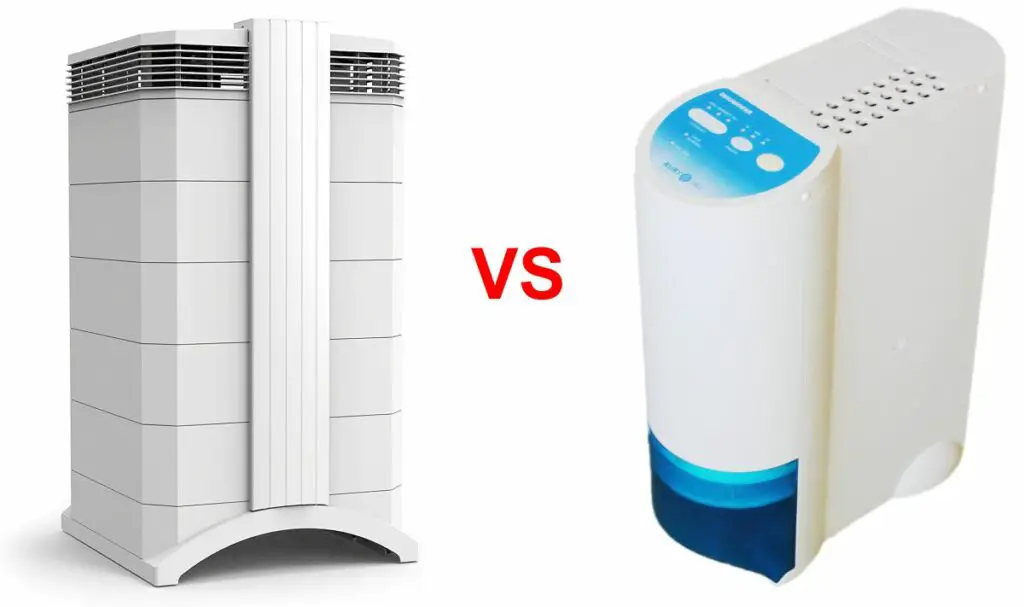
Do Air Purifiers Help With Mold?
